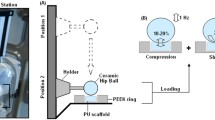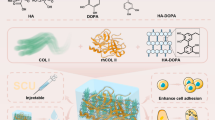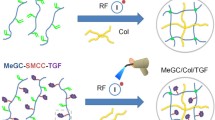Abstract
Hydrogel precursors are liquid solutions that are prone to leaking from the defect site once implanted in vivo. Therefore, the objective of the current study was to create a hydrogel precursor that exhibited a yield stress. Additionally, devitalized cartilage extracellular matrix (DVC) was mixed with DVC that had been solubilized and methacrylated (MeSDVC) to create hydrogels that were chondroinductive. Precursors composed of 10% MeSDVC or 10% MeSDVC with 10% DVC were first evaluated rheologically, where non-Newtonian behavior was observed in all hydrogel precursors. Rat bone marrow stem cells (rBMSCs) were mixed in the precursor solutions, and the solutions were then crosslinked and cultured in vitro for 6 weeks with and without exposure to human transforming growth factor β3 (TGF-β3). The compressive modulus, gene expression, biochemical content, swelling, and histology of the gels were analyzed. The DVC-containing gels consistently outperformed the MeSDVC-only group in chondrogenic gene expression, especially at 6 weeks, where the relative collagen II expression of the DVC-containing groups with and without TGF-β3 exposure was 40- and 78-fold higher, respectively, than that of MeSDVC alone. Future work will test for chondrogenesis in vivo and overall, these two cartilage-derived components are promising materials for cartilage tissue engineering applications.









Similar content being viewed by others
References
Adkisson, H. D., J. A. Martin, R. L. Amendola, C. Milliman, K. A. Mauch, A. B. Katwal, M. Seyedin, A. Amendola, P. R. Streeter, and J. A. Buckwalter. The potential of human allogeneic juvenile chondrocytes for restoration of articular cartilage. Am. J. Sports Med. 38:1324–1333, 2010.
Armstrong, C., and V. Mow. Variations in the intrinsic mechanical properties of human articular cartilage with age, degeneration, and water content. J. Bone Joint Surg. 64:88–94, 1982.
Beck, E. C., B. L. Lohman, D. B. Tabakh, S. L. Kieweg, S. H. Gehrke, C. J. Berkland, and M. S. Detamore. Enabling surgical placement of hydrogels through achieving paste-like rheological behavior in hydrogel precursor solutions. Ann. Biomed. Eng. 7:1–8, 2015.
Benders, K., P. van Weeren, S. Badylak, D. Saris, W. Dhert, and J. Malda. Extracellular matrix scaffolds for cartilage and bone regeneration. Trends Biotechnol. 31:169–176, 2013.
Brigham, M., A. Bick, E. Lo, A. Bendali, J. Burdick, and A. Khademhosseini. Mechanically robust and bioadhesive collagen and photocrosslinkable hyaluronic acid semi-interpenetrating networks. Tissue Eng. A 15:1645–1653, 2009.
Burdick, J. A., R. L. Mauck, J. H. Gorman, 3rd, and R. C. Gorman. Acellular biomaterials: an evolving alternative to cell-based therapies. Sci. Transl. Med. 5:176ps4, 2013.
Cha, M., S. Do, G. Park, P. Du, K.-C. Han, D. Han, and K. Park. Induction of re-differentiation of passaged rat chondrocytes using a naturally obtained extracellular matrix microenvironment. Tissue Eng. A 19:978–988, 2013.
Cheng, N.-C., B. T. Estes, H. A. Awad, and F. Guilak. Chondrogenic differentiation of adipose-derived adult stem cells by a porous scaffold derived from native articular cartilage extracellular matrix. Tissue Eng. A 15:231–241, 2008.
Cheng, N.-C., B. T. Estes, T.-H. Young, and F. Guilak. Engineered cartilage using primary chondrocytes cultured in a porous cartilage-derived matrix. Regen. Med. 6:81–93, 2011.
Cheng, N.-C., B. Estes, T.-H. Young, and F. Guilak. Genipin-crosslinked cartilage-derived matrix as a scaffold for human adipose-derived stem cell chondrogenesis. Tissue Eng. A 19:484–496, 2013.
Chun, S. Y., G. J. Lim, T. G. Kwon, E. K. Kwak, B. W. Kim, A. Atala, and J. J. Yoo. Identification and characterization of bioactive factors in bladder submucosa matrix. Biomaterials 28:4251–4256, 2007.
Decaris, M., B. Binder, M. Soicher, A. Bhat, and J. Leach. Cell-derived matrix coatings for polymeric scaffolds. Tissue Eng. A 18:2148–2157, 2012.
DeKosky, B., N. Dormer, G. Ingavle, C. Roatch, J. Lomakin, M. Detamore, and S. Gehrke. Hierarchically designed agarose and poly(ethylene glycol) interpenetrating network hydrogels for cartilage tissue engineering. Tissue Eng. C 16:1533–1542, 2010.
Dennis, S., M. Detamore, S. Kieweg, and C. Berkland. Mapping glycosaminoglycan-hydroxyapatite colloidal gels as potential tissue defect fillers. Langmuir 30:3528–3537, 2014.
Elder, A., N. Dangelo, S. Kim, and N. Washburn. Conjugation of β-sheet peptides to modify the rheological properties of hyaluronic acid. Biomacromolecules 12:2610–2616, 2011.
Elisseeff, J., C. Puleo, F. Yang, and B. Sharma. Advances in skeletal tissue engineering with hydrogels. Orthod. Craniofac. Res. 8:150–161, 2005.
Freytes, D. O., J. Martin, S. S. Velankar, A. S. Lee, and S. F. Badylak. Preparation and rheological characterization of a gel form of the porcine urinary bladder matrix. Biomaterials 29:1630–1637, 2008.
Garrigues, N. W., D. Little, J. Sanchez-Adams, D. S. Ruch, and F. Guilak. Electrospun cartilage-derived matrix scaffolds for cartilage tissue engineering. J. Biomed. Mater. Res. A 102:3998–4008, 2014.
Gershlak, J. R., J. I. Resnikoff, K. E. Sullivan, C. Williams, R. M. Wang, and L. D. Black. Mesenchymal stem cells ability to generate traction stress in response to substrate stiffness is modulated by the changing extracellular matrix composition of the heart during development. Biochem. Biophys. Res. Commun. 439:161–166, 2013.
Huang, C.-Y., A. Stankiewicz, G. A. Ateshian, and V. C. Mow. Anisotropy, inhomogeneity, and tension–compression nonlinearity of human glenohumeral cartilage in finite deformation. J. Biomech. 38:799–809, 2005.
Kanematsu, A., S. Yamamoto, M. Ozeki, T. Noguchi, I. Kanatani, O. Ogawa, and Y. Tabata. Collagenous matrices as release carriers of exogenous growth factors. Biomaterials 25:4513–4520, 2004.
Keane, T. J., I. T. Swinehart, and S. F. Badylak. Methods of tissue decellularization used for preparation of biologic scaffolds and in vivo relevance. Methods 84:25–34, 2015.
Khanlari, A., M. S. Detamore, and S. H. Gehrke. Increasing cross-linking efficiency of methacrylated chondroitin sulfate hydrogels by copolymerization with oligo (ethylene glycol) diacrylates. Macromolecules 46:9609–9617, 2013.
Kwon, J. S., S. M. Yoon, S. W. Shim, J. H. Park, K. J. Min, H. J. Oh, J. H. Kim, Y. J. Kim, J. J. Yoon, and B. H. Choi. Injectable extracellular matrix hydrogel developed using porcine articular cartilage. Int. J. Pharm. 454:183–191, 2013.
Levorson, E., O. Hu, P. Mountziaris, F. Kasper, and A. Mikos. Cell-derived polymer/extracellular matrix composite scaffolds for cartilage regeneration, Part 2: Construct devitalization and determination of chondroinductive capacity. Tissue Eng. C 20:358–372, 2014.
Liu, Y., Y. Zhang, P. Dong, R. An, C. Xue, Y. Ge, L. Wei, and X. Liang. Digestion of nucleic acids starts in the stomach. Sci. Rep. 5:11936, 2015.
Livak, K. J., and T. D. Schmittgen. Analysis of relative gene expression data using real-time quantitative PCR and the 2−ΔΔCT method. Methods 25:402–408, 2001.
Lu, H., M. Charati, I. Kim, and J. Burdick. Injectable shear-thinning hydrogels engineered with a self-assembling Dock-and-Lock mechanism. Biomaterials 33:2145–2153, 2012.
Mansour, J. M. Biomechanics of cartilage. In: Kinesiology: The Mechanics and Pathomechanics of Human Movement, edited by C. A. Oatis. Baltimore: Lippincott Williams & Wilkins, 2003, pp. 66–79.
McLennan, A., A. Bates, P. Turner, and M. White. BIOS Instant Notes in Molecular Biology. New York: Taylor & Francis, 2012.
Renth, A. N., and M. S. Detamore. Leveraging “raw materials” as building blocks and bioactive signals in regenerative medicine. Tissue Eng. B 18:341–362, 2012.
Rowland, C., D. Lennon, A. Caplan, and F. Guilak. The effects of crosslinking of scaffolds engineered from cartilage ECM on the chondrogenic differentiation of MSCs. Biomaterials 34:5802–5812, 2013.
Rughani, R. V., M. C. Branco, D. J. Pochan, and J. P. Schneider. De novo design of a shear-thin recoverable peptide-based hydrogel capable of intrafibrillar photopolymerization. Macromolecules 43:7924–7930, 2010.
Schwarz, S., A. F. Elsaesser, L. Koerber, E. Goldberg-Bockhorn, A. M. Seitz, C. Bermueller, L. Dürselen, A. Ignatius, R. Breiter, and N. Rotter. Processed xenogenic cartilage as innovative biomatrix for cartilage tissue engineering: effects on chondrocyte differentiation and function. J. Tissue Eng. Regen. Med. 2012. doi:10.1002/term.1650.
Schwarz, S., L. Koerber, A. F. Elsaesser, E. Goldberg-Bockhorn, A. M. Seitz, L. Durselen, A. Ignatius, P. Walther, R. Breiter, and N. Rotter. Decellularized cartilage matrix as a novel biomatrix for cartilage tissue-engineering applications. Tissue Eng. A 18:2195–2209, 2012.
Seif-Naraghi, S. B., D. Horn, P. J. Schup-Magoffin, and K. L. Christman. Injectable extracellular matrix derived hydrogel provides a platform for enhanced retention and delivery of a heparin-binding growth factor. Acta Biomater. 8:3695–3703, 2012.
Seif-Naraghi, S. B., M. A. Salvatore, P. J. Schup-Magoffin, D. P. Hu, and K. L. Christman. Design and characterization of an injectable pericardial matrix gel: a potentially autologous scaffold for cardiac tissue engineering. Tissue Eng. A 16:2017–2027, 2010.
Sutherland, A. J., E. C. Beck, S. C. Dennis, G. L. Converse, R. A. Hopkins, C. J. Berkland, and M. S. Detamore. Decellularized cartilage may be a chondroinductive material for osteochondral tissue engineering. PLoS One 10:e0121966, 2015.
Sutherland, A. J., G. L. Converse, R. A. Hopkins, and M. S. Detamore. The bioactivity of cartilage extracellular matrix in articular cartilage regeneration. Adv. Healthc. Mater. 4:29–39, 2015.
Tatman, P. D., W. Gerull, S. Sweeney-Easter, J. I. Davis, D.-H. Kim, and A. Gee. Multi-scale biofabrication of articular cartilage: bioinspired and biomimetic approaches. Tissue Eng. B 21:543–559, 2015.
Todd, R. H., and S. K. Daniel. Hydrogels in drug delivery: progress and challenges. Polymer 49:1993–2007, 2008.
Villanueva, I., C. A. Weigel, and S. J. Bryant. Cell–matrix interactions and dynamic mechanical loading influence chondrocyte gene expression and bioactivity in PEG-RGD hydrogels. Acta Biomater. 5:2832–2846, 2009.
Visser, J., P. A. Levett, N. C. te Moller, J. Besems, K. W. Boere, M. H. van Rijen, J. C. de Grauw, W. J. Dhert, P. R. van Weeren, and J. Malda. Crosslinkable hydrogels derived from cartilage, meniscus, and tendon tissue. Tissue Eng. A 21:1195–1206, 2015.
Wan, Y. S., S. Wei-Heng, and A. A. Ilhan. Elastic and yield behavior of strongly flocculated colloids. J. Am. Ceram. Soc. 82:616–624, 2004.
Wang, Q., Z. Gu, S. Jamal, M. S. Detamore, and C. Berkland. Hybrid hydroxyapatite nanoparticle colloidal gels are injectable fillers for bone tissue engineering. Tissue Eng. A 19:2586–2593, 2013.
Wang, Q., S. Jamal, M. Detamore, and C. Berkland. PLGA-chitosan/PLGA-alginate nanoparticle blends as biodegradable colloidal gels for seeding human umbilical cord mesenchymal stem cells. J. Biomed. Mater. Res. A 96:520–527, 2011.
Wang, Q., L. Wang, M. S. Detamore, and C. Berkland. Biodegradable colloidal gels as moldable tissue engineering scaffolds. Adv. Mater. 20:236–239, 2008.
Wang, Q., J. Wang, Q. Lu, M. Detamore, and C. Berkland. Injectable PLGA based colloidal gels for zero-order dexamethasone release in cranial defects. Biomaterials 31:4980–4986, 2010.
Yang, Z., Y. Shi, X. Wei, J. He, S. Yang, G. Dickson, J. Tang, J. Xiang, C. Song, and G. Li. Fabrication and repair of cartilage defects with a novel acellular cartilage matrix scaffold. Tissue Eng. C 16:865–876, 2010.
Acknowledgments
We would like to acknowledge the University of Kansas Macromolecule and Vaccine Stabilization Center and the Tertiary Oil Recovery Program for their assistance with particle sizing, the members of the KU Biomaterials and Tissue Engineering Lab who helped with porcine cartilage harvesting, and Heather Shinogle for her assistance with SEM imaging. We would like to recognize funding from the Kansas Bioscience Authority Rising Star Award, the National Institutes of Health via the KU Post Baccalaureate Research Education Program (NIH R25 GM078441), the National Science Foundation Graduate Research Fellowship (E.C.B.), the KU Graduate Fellowship (E.A.K), and the Madison & Lila Self Graduate Fellowship Educational Award (E.A.K).
Author information
Authors and Affiliations
Corresponding author
Additional information
Associate Editor Akhilesh Gaharwar oversaw the review of this article.
Electronic supplementary material
Below is the link to the electronic supplementary material.
Rights and permissions
About this article
Cite this article
Beck, E.C., Barragan, M., Tadros, M.H. et al. Chondroinductive Hydrogel Pastes Composed of Naturally Derived Devitalized Cartilage. Ann Biomed Eng 44, 1863–1880 (2016). https://doi.org/10.1007/s10439-015-1547-5
Received:
Accepted:
Published:
Issue Date:
DOI: https://doi.org/10.1007/s10439-015-1547-5




